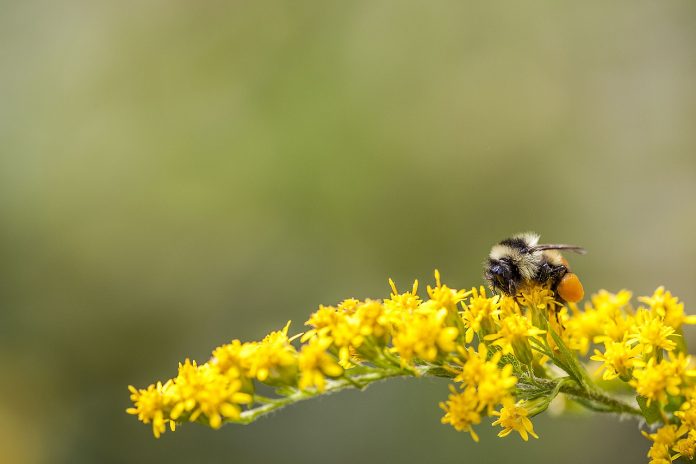Shorter days, cooler temperatures and bright fall colors signal the transition from summer to autumn.
Other signs include rusty and black banded wooly bears crossing country roads, yellow and black garden spiders roosting inside aging Queen Anne’s lace flower heads, and seas of brilliant goldenrod fading to a mellow yellow.
It was in a field of goldenrod where just a few plants retained their bright color that I recently came upon another sure sign of fall.
On a chilly evening earlier this week, I found several bumblebees perched on goldenrod flowers. They seemed hunkered down for the night. Because the temperature had already dipped into the 50s, they were barely moving.
When I moved the stems, the bees did not respond. Even under warmer conditions, bumblebees show little aggression so I didn’t fear getting stung.
Upon the first hard frost, which may have already occurred by the time you read this, these bumblebees will die.
Valuable queens
The fate of the population resides with recently impregnated queens that winter underground. Unlike honeybees, which overwinter in enclosed hives well stocked with food (honey), bumblebees rely on individual queens to make it through the winter and renew the population in the spring.
Queen bumblebees mate in the fall. The “lucky” males die shortly after mating, and the queens find an underground hibernaculum to spend the winter. They may use abandoned chipmunk or mouse burrows.
New colony
In the spring the queen searches for a place to establish a new colony. It may be underground, or she may use an old above-ground vole nest or just a dense tuft of grass.
She lines the nest with fine plant fibers and secretes wax from abdominal glands to form a “honeypot.”
Then she visits early spring blooming flowers and fills her crop with nectar, which she regurgitates into the honeypot.
Meanwhile, she’s also collecting protein-rich pollen at the flowers she visits. The pollen is collected on her furry body and on pollen baskets on her hind legs.
Back at the honeypot, the queen sheds the pollen into a waxy mass and lays up to a dozen fertilized eggs. (Remember, she mated back in the fall.)
She stays with the eggs and actually incubates them with her warm, fuzzy body. Unlike many insects, bumblebees can actually generate their own internal body heat via complex muscular activity.
After the eggs hatch, the queen provides additional nectar and pollen as needed. During the larva’s two to three week period of development, the queen builds another honeypot and repeats the process.
Continued cycle
This continues throughout the spring and summer until the colony reaches a size of two to three hundred individuals.
Until late summer, all the queen’s offspring are sterile females. They tend the honeypots and feed each new brood of bumblebees.
As fall approaches, the workers provide a near constant supply of food to the final generation of bumblebee larvae. It is these late summer bumblebees that develop into fertile adult males and females. That brings the colony full circle.
Fertile males and females mate, the males die, and the next generation of mated queens retire to underground dens for the winter.
Pollination by most bees, wasps, butterflies, beetles, bats, and hummingbirds is mechanical and incidental. As pollinators visit flowers for nectar, pollen adheres to body parts, and they carry it to flowers where pollination occurs.
Unique strategy
But bumblebees use another fascinating pollination technique. Some plants require a sonic stimulus to release pollen. Bumblebees oblige by grasping the pollen-containing anthers and producing an audible buzzing sound as they work the flowers.
The sound is caused by rapid-fire contractions of the flight muscles, vibrations of which are transmitted inside the hollow anthers.
Bumblebees act as living tuning forks and cause the pollen to be sonically discharged as an explosive cloud.
Stephen Buchmann, co-author of The Forgotten Pollinators (1996, Island Press) calls this “buzz pollination.”
Among the 20,000 worldwide species of plants that require buzz pollination are several important food crops — blueberries, cranberries, some peppers, eggplants, kiwi fruits and tomatoes.
Our lives and the dinner table just wouldn’t be the same without bumble bees.













